Mary Anne Yarde's Blog: The Coffee Pot Book Club , page 163
November 25, 2018
My Inspiration for Kindred Spirits: Westminster Abbey by Jennifer Wilson #amwriting #Paranormal #HistoricalFiction @inkjunkie1984
My Inspiration for Kindred Spirits: Westminster Abbey.By Jennifer Wilson

Kindred Spirits: Westminster Abbey was meant to be the second in the Kindred Spirits series, not the third, but when I sat down and started making notes about which ghosts would be amongst my ‘cast’, I’ll admit I was overwhelmed by the task, and looked about for an alternative, hence we travelled north to Edinburgh for book two instead. With two books completed though, I knew I had to tackle the big one, and head to Westminster. The inspiration behind the overall concept of KS: Westminster Abbey is the same as for the previous two books in the series; which ghosts are likely to still be found in any given place, after all these years, and who would (or would not) get along together. Once the notion of Richard III and Anne Boleyn having quite a bit in common struck me for KS: Tower of London, I fell in love with the idea, and now find it difficult to visit any historical location without thinking about who might be loitering, waiting to surprise an unsuspecting tourist. For Westminster Abbey, I spent a lot of time reading accounts of ghost stories, historical trivia, and lists of burials, to come up with a set of characters which would most inspire me. Elizabeth I was a given, as was her half-sister Mary I, and Mary, Queen of Scots, just to add a bit of tension into the mix. But, frustratingly, whoever else I looked at including, I kept coming back to Henry VII as my central male character. He was connected to so many of them, for starters, but also, he seemed a logical lead for the discussions and debates which would no doubt take place between so many noble and regal spirits. I tried so hard to avoid it; I really didn’t want to end up having sympathy for Henry Tudor! Still, if you’re going to add conflict for Henry Tudor, it does really only leave one interesting option… For me, the greatest inspiration, after that initial idea has struck, comes from physically nosing around my chosen setting. I think it’s only once I get into a place, get a sense of it, that real inspiration can really start to flow, as I notice little nooks and crannies, or routes around a place. This, for me, means I can also add a sense of realism, as I think my biggest dread would be somebody saying “but you cannot walk from there to there” – even with ghosts as central characters, the geography has to be right! If I’m honest though, meandering about historical buildings and sites is never a hardship for me. It also means you stop yourself from making huge mistakes, like not realising you really cannot see much of Anne of Cleves’ tomb these days (much to her ghost’s annoyance). Hardly any of my story ideas come to me whilst sitting at my desk. Yes, I’ll work up notes when I’m sat at home, adding in detail, but that initial buzz of a plot nearly always comes when I’m mid-visit. There’s just something a bit special about being in places where so many people have lived, loved, lost and died. It’s the practical side of things too, like making my way around the many spiral staircases of Linlithgow Palace earlier this year, and thinking (1) it must have taken an age to work out where everything was when you were new, and (2) this would not have been easy in a flowing gown and court shoes (it was tricky enough in jeans and trainers!). It means, when writing ‘straight’ historical fiction (i.e. none of my ghosts who don’t need to worry about such things), you have to be aware of the very real trip hazard, if your heroine suddenly needs to make a run for it. It’s hard to talk about my inspiration without sounding a bit soppy and mystical, but I truly believe a place can do that to you, if you’re open to it. Just as when I was wandering around the Tower of London in a February blizzard, thinking about how it would have been to be there in the times without central heating, or how it would feel to hear the scaffold for your own death being built outside your window. I do truly believe that walls can talk, if you just start listening!
Kindred Spirits: Westminster Abbey

With over three thousand burials and memorials, including seventeen monarchs, life for the ghostly community of Westminster Abbey was never going to be a quiet one. Add in some fiery Tudor tempers, and several centuries-old feuds, and things can only go one way: chaotic.Against the backdrop of England’s most important church, though, it isn't all tempers and tantrums. Poets' Corner hosts poetry battles and writing workshops, and close friendships form across the ages.With the arrival of Mary Queen of Scots, however, battle ensues. Will Queens Mary I and Elizabeth I ever find their common ground, and lasting peace?The bestselling Kindred Spirits series continues within the ancient walls of Westminster Abbey.
Amazon
Jennifer C. Wilson
 Jennifer C. Wilson is a marine biologist by training, who developed an equal passion for history whilst stalking Mary, Queen of Scots on childhood holidays (she has since moved on to Richard III). She completed her BSc and MSc at the University of Hull, and has worked as a marine environmental consultant since graduating. Enrolling on an adult education workshop on her return to the north-east of England reignited her pastime of creative writing, and she has been filling notebooks ever since. In 2014, Jennifer won the Story Tyne short story competition, and has been working on a number of projects since, including co-hosting the North Tyneside Writers’ Circle. Her Kindred Spirits novels are published by Crooked Cat Books and her timeslip novella The Last Plantagenet? by Ocelot Press. She can be found online at the following locations: Website • Facebook • Twitter • Instagram.
Jennifer C. Wilson is a marine biologist by training, who developed an equal passion for history whilst stalking Mary, Queen of Scots on childhood holidays (she has since moved on to Richard III). She completed her BSc and MSc at the University of Hull, and has worked as a marine environmental consultant since graduating. Enrolling on an adult education workshop on her return to the north-east of England reignited her pastime of creative writing, and she has been filling notebooks ever since. In 2014, Jennifer won the Story Tyne short story competition, and has been working on a number of projects since, including co-hosting the North Tyneside Writers’ Circle. Her Kindred Spirits novels are published by Crooked Cat Books and her timeslip novella The Last Plantagenet? by Ocelot Press. She can be found online at the following locations: Website • Facebook • Twitter • Instagram.
Published on November 25, 2018 23:00
Please help us Protect Killiecrankie Battlefield. #Killiecrankie #Jacobite #Scotland @KilliecrankieA9
Published on November 25, 2018 03:27
November 24, 2018
#BookReview — The Black Lions of Flanders (The King's Germans Book #1) By Dominic Fielder #HistoricalFiction @Kings_Germans

The Black Lions of Flanders (The King's Germans Book #1)By Dominic Fielder

In the war of the First Coalition, friend and foe know one simple truth: trust your ally at your own peril.
February 1793.
Private Sebastian Krombach has joined the army to escape the boredom of life in his father’s fishing fleet. Captain Werner Brandt yearns to leave his post and retire into civilised society and Lieutenant Erich von Bomm wants nothing more than to survive his latest escapade that has provoked yet another duel. Each man is a King’s German; when they are called to war, their lives will become inextricably linked.
The redcoats of the 2nd Battalion, 10th Regiment, must survive the divisions that sweep through their ranks before they are tested in combat. On the border of France, the King’s Germans will face an enemy desperate to keep the Revolution alive: the Black Lions of Flanders.
Amazon US • Amazon UK

“I pardon the authors of my death, and pray God that the blood you are about to shed will never fall upon France…”The reputed last words of King Louis XVI
On 21 January 1793 at the Place de la Révolution, King Louis XVI of France met with Madam Guillotine. When his head was held up the crowd cheered:
“Vive la Nation! Vive la République!”
However, executing King Louis XVI was only the beginning. France, with her new Revolutionary Government, had set her eyes on the rest of Europe. Eleven days later France declared war on Britain. King George III of Britain and prince-elector of Brunswick-Lüneburg (Hanover) was forced into a war. Only time will tell if George III's Hanoverian troops — The King’s Germans — will be enough to make the French rethink their plans.
Dominic Fielder’s debut novel The Black Lion of Flanders (The King’s Germans Book #1) is a historical triumph. The storytelling is vivid, violent, and victorious. Fielder has brought this era back to life in his masterfully written and vastly entertaining tale.
Like a master puppeteer, Fielder has a firm control of a large cast of characters. Drawing inspiration from complicated historical figures, and, up until then, one of the most turbulent times in French history, Fielder has taken the somewhat ambitious decision to describe both sides of the war. This was a risk, for sometimes the constant chopping and changing of sides can confuse the reader, but Fielder pulled this off wonderfully. Helped, without a doubt, by some very memorable characters such as the Dragoon Captain, Beauvais and the beautiful, yet resourceful, Countess of Marboré.
Fielder has an excellent eye for human detail — nothing is beyond the telling. His portrayal of the harshness of a soldier’s life spares no detail, nor does he spare his readers from the driving ambition of historical figures such as Charles François Dumouriez.
There is also a richness in the descriptive text. Fielder describes this troubled time with great respect to the history but also with a wonderful insight of his readers.
The Black Lion of Flanders (The King’s Germans Book #1) is very much a story where everything seems to be balancing on the blade of a bayonet. I sympathised with many of the characters, and I despised a few. But more importantly, I was swept along in a story that was so utterly compelling from start to finish that time simply flew by as I lost myself within the pages of this remarkable book.
Reading this book was like taking a step back in time, and as a bystander I watched this story unfold. Together with the political intrigue, the soldiers unrest and resentment, the poor preparations of the British Army, as well as the complicated alliances, this story is a must read for those interested in this era of history.
I Highly Recommend.
Review by Mary Anne Yarde.
The Coffee Pot Book Club.
Dominic Fielder
 Dominic Fielder (1968-present) was born in Plymouth to parents of families from Roman Catholic and Protestant backgrounds. Then such things mattered to others but not to a first-born son who knew only love and a stable happy family. Two brothers made for a warm and somewhat idyllic childhood. He was bright but a disengaged student preferring instead to spend time with his dad at the family book business (the Bookstall) where a love of literacy flourished. Having finished sixth-form at Devonport High School for Boys, he passed opportunities to join first, the Tank Regiment, then the Royal Air Force, settling instead on a career in banking. Three years later, fed up with counting other people’s money, he travelled to Australia for a year, working for a time in the Outback and thoroughly enjoying life!
Dominic Fielder (1968-present) was born in Plymouth to parents of families from Roman Catholic and Protestant backgrounds. Then such things mattered to others but not to a first-born son who knew only love and a stable happy family. Two brothers made for a warm and somewhat idyllic childhood. He was bright but a disengaged student preferring instead to spend time with his dad at the family book business (the Bookstall) where a love of literacy flourished. Having finished sixth-form at Devonport High School for Boys, he passed opportunities to join first, the Tank Regiment, then the Royal Air Force, settling instead on a career in banking. Three years later, fed up with counting other people’s money, he travelled to Australia for a year, working for a time in the Outback and thoroughly enjoying life!On returning to the UK, he drifted into work at his family’s Comic Shop (Kathies Comics). Despite fifteen years of hard work, the business failed and so did his marriage. Working a series of odd jobs, with odd hours, he finished a degree course in History, gaining a First and drifted into the world of education. Now he divides his time unequally between private tuition, running the family book business which has survived for sixty years and writing. More important than all of these, is spending time with his son. With what free time he has, he enjoys cycling, walking and horse-riding on the moors that surround his home in Mary Tavy, Devon.
His passion and interest for as many years as he can care to remember has been ‘little model soldiers’, painting them, researching facts about the regiments and playing wargames with them. For a dozen years or more, Dominic ran a series of ‘Megagames’ where people would arrive from all corners of the globe to game out World War Two scenarios for a week. Such events needed a strong narrative and his first attempts at writing were contained within the pre-game intelligence and the post-action reports. His writing project, ‘The King’s Germans’ is a few steps further down that road. For the person who drifted from one task to another, it’s a commitment to write twenty-two years of the history of Hanoverian soldiers in the service of King George III.
Connect with Dominic on: Facebook • Twitter.
Published on November 24, 2018 23:00
November 23, 2018
#BookReview — Sons of the Wolf: Sons of the Wolf : Book #1 by Paula Lofting #AngloSaxon #HistoricalFiction @Paulalofting
 Sons of the Wolf:Sons of the Wolf : Book #1
Sons of the Wolf:Sons of the Wolf : Book #1By Paula Lofting
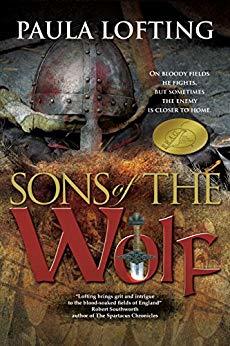
On the battlefield, Wulfhere fights for his life but elsewhere the enemy is closer to home, sinister and shadowy and far more dangerous than any war.
1054, pious King Edward sits on the throne, spending his days hunting, sleeping and praying, leaving the security of his kingdom to his more capable brother-in-law Harold Godwinson, the powerful Earl of Wessex. Against this backdrop we meet Wulfhere, a Sussex thegn who, as the sun sets over the wild forest of Andredesweald, is returning home victoriously from a great battle in the north. Holding his lands directly from the King, his position demands loyalty to Edward himself, but Wulfhere is duty-bound to also serve Harold, a bond forged within Wulfhere's family heritage and borne of the ancient Teutonic ideology of honour and loyalty.
Wulfhere is a man with the strength and courage of a bear, a warrior whose loyalty to his lord and king is unquestionable. He is also a man who holds his family dear and would do anything to protect them. So when Harold demands that he wed his daughter to the son of Helghi, his sworn enemy, Wulfhere has to find a way to save his daughter from a life of certain misery in the household of the cruel and resentful Helghi without compromising his honour and loyalty to his lord, Harold.
Sons of the Wolf is a panoramic snapshot of medieval life and politics as the events that lead to the downfall of Anglo Saxon England play out, immersing the reader in the tapestry of life as it was before the Doomsday Book. With depictions of everyday life experienced through the minds of the peoples of the time; of feasts in the Great Halls to battles fought in the countryside, it cannot help but enlighten, educate and entertain.

Bloody. Brutal. Brilliant.
The greatest warriors of the land descended from wolves. Sea Wolves — that was what their enemies had called them. They were fearsome creatures, the stuff of legends. But such things were not talked about anymore. For Englalond is a Christian country now. Nevertheless, when the moon is at its fullest, and if you listen carefully, you can still hear the Sea Wolves as they howls, for such men will never be silenced.
As the cries of the dying fall silent on Dunsinane Hill, Wulfhere can finally return home to Horstede. Although he is glad to leave the bloodshed behind him, he fears what kind of reception he will receive, for his wife is yet to forgive him for his gross betrayal.
At court, it has become increasingly apparent that pious King Edward will never produce an heir. So who will be king when Edward dies? With the Godwin’s once again the most prominent family in Englalond, the nobles of the land can do nothing but speculate. Will the next King of Englalond hail from Wessex, or will he, God-forbid, hail from Normandy?
Wulfhere’s loyalty to Harold Godwin is without question, and although he does not always agree with him, he will stand and fight, for the wolf inside of him cannot be silenced any longer.
From the peaceful tranquillity of Wulfhere’s land in Horstede to the slaughter at Hereford in 1055, Sons of the Wolf (Sons Of The Wolf #1) by Paula Lofting is one of the most compelling stories set in this era that I have ever read.
When flicking through the pages of The Doomsday Book, I have often wondered who were these people whose names have been preserved for all eternity. It seems that Lofting has asked herself the same thing, for she has taken some of these names and breathed life back into them.
This is a story about love and hate. Loyalty and betrayal. It is a story that is forever timeless but somehow new. The writing is elegant, the descriptions beautiful. Lofting’s words wrapped around me and suddenly I found myself in this new place, where the customs seemed unfamiliar, but the love for one’s family is the same as it ever was. Lofting’s attention to detail has to be commended — from what her characters wear to how they reacted in times of terrible struggle. There is an integrity in her writing. It was believable. This is a long book, but reading it was effortless. I became immersed in the story and the hours flew by. The narrative was flawless.
I thought Wulfhere was exquisitely drawn. Wulfhere is a flawed character, but for me, that made him all the more credible. He makes many mistakes, but he pays for them. He does not run away or pass the blame. He owns his mistakes, and at the end of the day, he only wants what is best for his children. His feud with his neighbour, the vile Helghi, brings tension to the story. There is always this element of expectation. What is Helghi going to do next? Helghi is a wonderful antagonist to pit against Wulfhere. Wulfhere is honourable, Helghi is not.
Wulfhere’s daughter, Freyda, surely tests his patience. However, I felt a great sympathy for her. She is young and thinks herself in love. While Wulfhere battles to keep her safe, she fights him every step of the way. It is a believable, and an incredibly emotional relationship the two of them have which I found incredibly compelling.
Both Wulfhere and Helghi are historical characters, but I think it was the drawing of some more well-known ones such as Harold Godwin, which closed the deal on this book for me. Lofting has taken the sources and presented Harold as I have always imagined him to be. He is honourable, loyal and he loves his country. I am trying my hardest not to become too attached to Lofting characterisation of Harold, for I know how his story ends!
If you are looking for your next fix of historical fiction, then pick up a copy of Paula Lofting’s Sons Of The Wolf. You won’t regret it.
I Highly Recommend.
Review by Mary Anne Yarde.The Coffee Pot Book Club Book Award.
Amazon UK • Amazon US
Paula Lofting
 Paula has always wanted to write since she was a little girl coming home from school to sit at the table with her notebook. A prolific reader, she loved nothing better than to spend weekends with a book in her hand. Earliest influences such as Rosemary Sutcliffe, Leon Garfield, Charles Dickens, C.S.Lewis, inspired an interest in history. It became her lifelong wish to one day write and publish a book, but not being able to type, and having no funds for a typewriter to learn on, this ambition was reluctantly put on hold. With the advent of PC's and a need to retrain and use a computer, this old ambition was stirred and she decided to rekindle her love of writing at the grand old age of 42. At this point, she had reached a turning point in her life and studied nursing, and also decided to write the book she had been promising herself she would one day write. Her début novel, 'Sons of the Wolf' was first published with the assistance of Silverwood Books in 2012. More recently she has republished it with her new publishing company Longship Publsihing. in kindle. It is a story set in the years leading up to the Norman Conquest of England and the first in the Sons of the Wolf series. She has always admired the works of Sharon Penman and Bernard Cornwell, and Mary Stewart, amongst many others. History is a great love of hers and her interest in the subject goes beyond that of the keyboard. She also enjoys Anglo-Saxon re-enactment with Regia Anglorum, also a great source of research for her writing.
Paula has always wanted to write since she was a little girl coming home from school to sit at the table with her notebook. A prolific reader, she loved nothing better than to spend weekends with a book in her hand. Earliest influences such as Rosemary Sutcliffe, Leon Garfield, Charles Dickens, C.S.Lewis, inspired an interest in history. It became her lifelong wish to one day write and publish a book, but not being able to type, and having no funds for a typewriter to learn on, this ambition was reluctantly put on hold. With the advent of PC's and a need to retrain and use a computer, this old ambition was stirred and she decided to rekindle her love of writing at the grand old age of 42. At this point, she had reached a turning point in her life and studied nursing, and also decided to write the book she had been promising herself she would one day write. Her début novel, 'Sons of the Wolf' was first published with the assistance of Silverwood Books in 2012. More recently she has republished it with her new publishing company Longship Publsihing. in kindle. It is a story set in the years leading up to the Norman Conquest of England and the first in the Sons of the Wolf series. She has always admired the works of Sharon Penman and Bernard Cornwell, and Mary Stewart, amongst many others. History is a great love of hers and her interest in the subject goes beyond that of the keyboard. She also enjoys Anglo-Saxon re-enactment with Regia Anglorum, also a great source of research for her writing.Paula loves to hear from readers, you can find her: Website• Blog• Facebook • Twitter.
Published on November 23, 2018 23:00
#BookReview — The Swan Keeper #HistoricalFiction #Montana @milanamarsenich
 The Swan KeeperBy Milana Marsenich
The Swan KeeperBy Milana Marsenich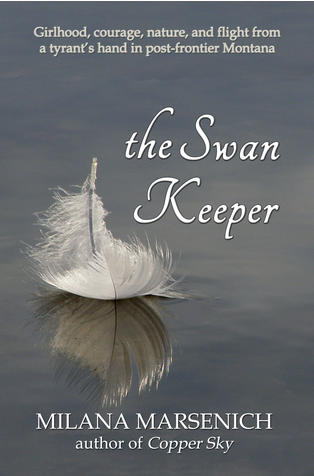
From USA Today featured novelist and Western Writers of America Spur award finalist Milana Marsenich, The Swan Keeper is an historical, coming-of-age novel set in 1920s Montana.
On her eleventh birthday, Lilly’s family visits the Cattail Marsh to see the newly hatched cygnets. The family outing turns tragic when Dean Drake shows up with his shotgun. Lilly sees him kill her father, injure her mother, and slaughter the bevy of trumpeter swans. The sheriff, her mother, sister, and best friend all think Lilly is trying to make sense of a senseless accident by blaming Drake. But Lilly knows the truth. Left alone she must bring him to justice.

All you needed was love. If you had love, anything was possible. Or at least that is what Lilly used to think. She was eleven when it happened. It was on her birthday.
Lilly can still see him when she closes her eyes. She can see Dean Drake as he raises his gun and fires at the lake and the trumpeter swans that are upon it. It haunts her. Just as the swans haunt her.
However, the swans were not the only casualties that dreadful day. Lilly had seen what Dean Drake did. She knew. But no one believed her. And no one will listen.
If it were not for the swans, then Lilly knew she would never have had the courage to carry on. Pearl, an injured swan, needed her, as did the swans at the lake. She was the swan keeper now, and it was her duty to protect them, as it was her duty to bring the man who murdered her father and shot her mother to justice.
The Swan Keeper by Milana Marsenich is one of the most hauntingly beautiful books that I have ever read. From the first sentence, I was utterly captivated.
The prose is as elegant as a swan upon the water. Majestic. Timeless. Beautiful. Ms Marsenich's use of language enthralled me. It was like sipping the most exquisite wine — only this wine was made of words. Marsenich uses all the senses, from touch to taste, but particularly the sense of smell. Marsenich does this remarkably well. You know when the antagonist is near before he is even mentioned because you can smell him. The writing jumped from the pages, and I found myself in Montana in the late 1920s. Reading this book was as effortless as it was enchanting. I cherished each word, each sentence. This is the kind of story that you simply cannot put down until the end.
Lilly is such an imaginative child. Life for her is full of wonder and possibilities. Nature calls her. It talks to her in a way that it does not for most of us. The swans fascinate her to such an extent that she can imagine herself being one. They are her escape. They are her everything. She can think of no better birthday than a picnic by the lake. What happens next changes Lilly’s life forever, and the fact that she isn’t believed makes this story all the more heart-breaking. I adored the characterisation of Lilly. She is such a sweetheart and so incredibly caring, not only towards the swans but to her mother as well, who is nothing but a shell since the attack. Her young heart is terribly broken by what she witnessed and what she knows, but her determination and her drive to find tangible evidence that Dean killed her father shows her strength of character. Marsenich’s portrayal of Lilly was absolute perfection. Alongside this desperate longing for justice there is this vulnerable little girl, who is innocent, but beginning to understand about love for someone who is not a relative. Her relationship with Jerome — her slightly older best friend — gives the reader hope that in the future Lilly will be loved the way she deserves to be.
The antagonist, Dean Drake, is very manipulative, and his treatment of Lilly is nothing short of appalling. He is the nightmare that has stolen her dreams as well as her father and mother. Dean is the ruthless hunter whereas Lilly is the innocent swan. The two contrast each other very well. This book is very much about light and darkness. This is a story of an evil man and a pure and beautiful swan keeper.
If you are looking for your next great read, then The Swan Keeper by Milana Marsenich will not disappoint.
I Highly Recommend.
Review by Mary Anne YardeThe Coffee Pot Book Club Book Award.
Amazon US • Amazon UK
Milana Marsenich
 Milana Marsenich lives in Northwest Montana near Flathead Lake at the base of the beautiful Mission Mountains. She enjoys quick access to the mountains and has spent many hours hiking the wilderness trails with friends and dogs. She has an M.Ed. in Mental Health Counseling from Montana State University and an MFA in Creative Writing from the University of Montana. She has previously published in Montana Quarterly, Big Sky Journal, The Polishing Stone, and Feminist Studies. She has a short story included in The Montana Quarterly book: Montana, Warts and All, The Best From Our First Decade. Copper Sky is her first novel.
Milana Marsenich lives in Northwest Montana near Flathead Lake at the base of the beautiful Mission Mountains. She enjoys quick access to the mountains and has spent many hours hiking the wilderness trails with friends and dogs. She has an M.Ed. in Mental Health Counseling from Montana State University and an MFA in Creative Writing from the University of Montana. She has previously published in Montana Quarterly, Big Sky Journal, The Polishing Stone, and Feminist Studies. She has a short story included in The Montana Quarterly book: Montana, Warts and All, The Best From Our First Decade. Copper Sky is her first novel.Connect with Milana: Website • Facebook
Published on November 23, 2018 23:00
Very excited to announce that Myths, Legends, Books & Coffee Pots is now offering some fantastic discounts for authors with regards to #publishing and #promoting.

A word from Mary Anne…
Myths, Legends, Books & Coffee Pots was founded in 2015 and has gone from strength to strength. In 2016 I began to invite historical fiction authors and historical fantasy authors onto my blog to share their inspiration behind their books. This was an instant hit with my readers, and I have been inviting authors of these genres onto my blog ever since. This blog has a very loyal readership and has on average 30,000-page visits per month.
I think many authors, particularly independent authors, can relate to me when I say what a terrible struggle it is to get your book in front of readers, which is why I am working with some of the best book promoters in the industry. All of the services on offer have my seal of approval. I would not recommend any service that I have not had experience with myself. There is something here for every budget, and I am always striving to find new offers and deals.
Guest Post on Myths, Legends, Books & Coffee Pots
Writing a guest post is a wonderful way for new readers to find your books. This service I offer for FREE.
To find out more, click HERE!
The Coffee Pot Book Club:
Editorial Book Reviews
I know how essential book reviews are to authors. This is why I now offer an Editorial Book Review Service. To find out more, click HERE!
NetGalley with Books Go Social

Are you looking for a safe and legitimate way to gain interest and reviews for your Book?Would you like to get your book in front of Professional Reviewers?Would you like to use a service that is used by all the major publishing houses?To find out more, click HERE!
Book Cover Designswith Books Go Social
They say that you cannot judge a book by its cover. This is true, but a great cover will certainly help sell your book. To find out more about professional and more importantly affordable book covers, click HERE!
Book Trailerswith Books Go Social
A Book Trailer is a great marketing tool. What can be better than a book trailer for you book?Coming soon...
Fast Track Marketing Coursewith Books Go SocialA great selection of marketing courses which will help your book succeed. Coming soon...
Editing Service with GraceIf you are looking for a professional editing service then look no further. For more information click HERE!
Blog Tours
With Historical Fiction Virtual Blog Tours (HFVBT)
Coming soon!
Social Media Promotion
With N.N.Light's Book Heaven
N. N. Light Author Promotions. . . an author’s best friend while matching books to readers since 1990. To find out more click HERE!
Pre-Publication Package
Coming soon!
New Release Package
Coming soon!
Published on November 23, 2018 00:28
November 22, 2018
Richard III novelists collaborate on charity anthology. #RichardIII #Scoliosis @PhilippaGBooks @AlexMarchant84
Richard III novelists collaborate on charity anthology...
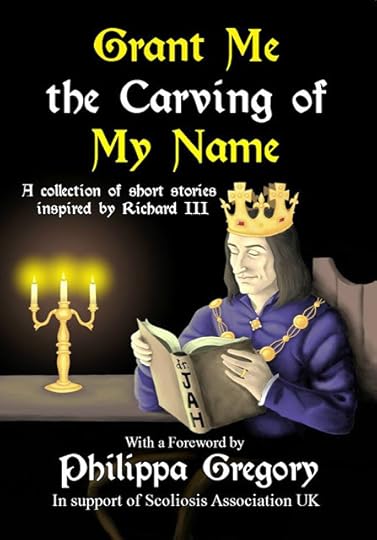
An international group of authors who have all been inspired by England’s last Plantagenet King, Richard III, are working together to raise funds in support of Scoliosis Association UK through sales of a collection of their work.Grant Me the Carving of My Name is an anthology of 15 short stories by a dozen authors from the UK, Ireland, the USA and Australia. It takes its title (with her permission) from a poem by poet laureate Carol Ann Duffy which was read by Benedict Cumberbatch at the king’s reburial in Leicester in 2015.The collection also features a Foreword by acclaimed historical novelist Philippa Gregory, author of The White Queen, which was dramatized by the BBC in 2013 and featured a rare positive portrayal of King Richard, by Aneurin Barnard (Dunkirk, War and Peace).
‘This collection has come about – as so many good things do – from a dream and a joke…’Philippa Gregory
When editor Alex Marchant and Wendy Johnson, a key member of the Looking for Richard Project responsible for rediscovering the king’s grave, joked about getting together to publish short stories they had written about this most controversial king. The enthusiasm of the other authors approached led to the dream becoming a reality.The collected stories offer an alternative view of this often-maligned king and range from glimpses of his childhood and domestic life, through battles and rebellions, to explorations of the afterlife and his historical reputation. By turns elegiac, mystical, brutal, light-hearted, uplifting, there’s something for everyone within these pages.
The charity
King Richard himself suffered from scoliosis– a lateral curvature of the spine that would have become increasingly disabling and painful as he aged, and was only revealed during examination of his skeleton after his grave was excavated in 2012. Scoliosis Association UK (SAUK) supports children and adults with the same condition throughout the UK today and was the obvious charity to support with proceeds from this book.
The editor and authors
Alex Marchant is author of two books telling the story of the real King Richard III through the eyes of a young page in his service. While aimed at children aged 10+, The Order of the White Boar and The King’s Man have also been enjoyed by adults They have been called ‘a wonderful work of historical fiction’ by the Richard III Society, and recently received a Discovered Diamond award from the Discovering Diamonds review website.The Order of the White Boar is largely set in and around Middleham Castle in Wensleydale, King Richard’s primary home in the north of England, and also York, not far from where Alex now lives. Two other contributors, Wendy Johnsonand Marla Skidmore, also live close by in North Yorkshire, with Jennifer C. Wilson based not far away in Tyneside, meaning the core of the authors are northern-based – as was King Richard for much of his life before he became king. In fact, he referred to a return to Yorkas a ‘homecoming’ in letters, and on his royal progress following his coronation, he wended his way back up through the country to the city, where his rapturous reception was such that he immediately decided to invest his young son, Edward, as Prince of Wales in the Minster. No wonder, then, that Richard is often seen as England’s only ‘northern’ king.The contributorsNarrelle M. Harris • Wendy Johnson • Riikka Katajisto • Susan Kokomo Lamb • Joanne R. Larner • Matthew Lewis • Alex Marchant (editor) • Máire Martello A playwright based in Manhattan • Frances Quinn • J. P. Reedman • Marla Skidmore • Richard Unwin • Jennifer C.Wilson
Grant Me the Carving of My Name can be pre-ordered as an ebook and will be available as a paperback also from 24th November 2018 through Amazon at mybook.to/GrantMetheCarvingand via editor Alex Marchant and contributors.It will be launched online at:https://www.facebook.com/events/271580673561044/ and Alex will also be selling and signing copies and chatting about life as an author at The Kitchen café-bar, Haworth Road, Cross Roads, Keighley from 3 p.m. on Thursday 6th December and at Harrogate Library on Wednesday 12th December from 1.30 p.m.
For more information, please contact Alex at:AlexMarchant84@gmail.com /
Published on November 22, 2018 01:07
November 21, 2018
Succession of Richard II by Mercedes Rochelle #History #MiddleAges @authorrochelle
Succession of Richard II
by Mercedes Rochelle
At first glance, one might not question the law of succession in England during the Middle Ages, but in reality the rules were open to interpretation, which is one reason the Wars of the Roses were fought with such intensity. As far back as King John, we see the youngest brother of a previous king mount the throne rather than the son of an elder brother (Arthur of Brittany—son of Geoffrey—should have ruled if the tradition of primogeniture were followed). Even Edward I, after the death of his three eldest sons, declared an order of succession that included his daughters. When it was Richard II's turn, the issue was far from settled.
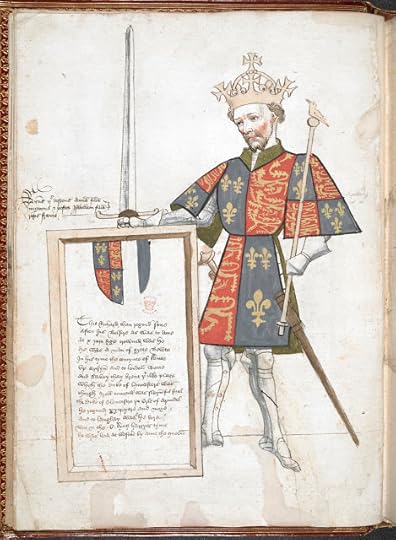
Richard II from Sir Thomas Holme's Book of Arms, British Library: MS Harley 4205 f.6V
In 1376, Edward the Black Prince was dying. His child Richard, who was himself the second son (the first son Edward had died two years previously), was only nine years old. The Black Prince took nothing for granted, and on his deathbed he asked both his father and his brother John of Gaunt to swear an oath to protect Richard and uphold his inheritance. Even this precaution didn't guarantee Richard's patrimony, and Edward III felt obliged to create an entail that ordered the succession along traditional male lines. This meant that the Mortimers, descendants of Gaunt's deceased elder brother Lionel (through his only daughter Philippa) were excluded. It also meant that John of Gaunt was next in line after Richard, and after him, Henry of Bolingbroke.
By this time, Edward III was an enfeebled old man and Gaunt had already started attending Parliament in his name. At this stage of his life, John of Gaunt was an overbearing, arrogant bully and he was incredibly unpopular. There were great fears—probably unfounded—that he would usurp the throne from his nephew; most historians believe that because of this, Edward III's entail was not publicized. Presumably only the inner family and the great officers knew about its existence. After all, why inflame the public unnecessarily? If Richard were to sire an heir, the whole entail would be moot.
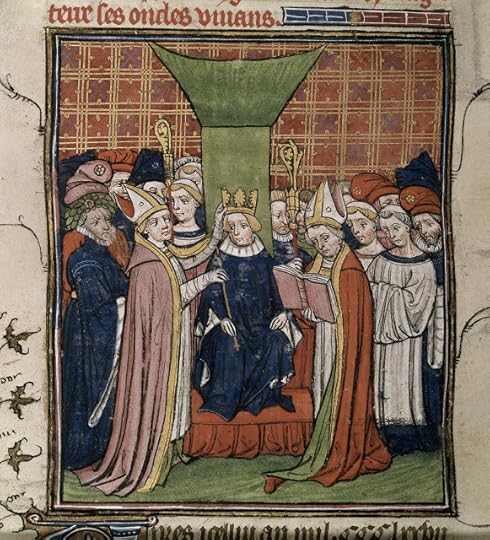 Coronation of Richard II from British Library Royal 20 C VII [image error]f. 192v
Coronation of Richard II from British Library Royal 20 C VII [image error]f. 192vSo the ten year-old Richard was crowned king; nobody wanted to take a chance on a less-than-secure regency. But this was not the end of the story. In the short run, of course, there was no reason to give the succession much thought. Richard married at age fifteen and his queen was only a year older than him. But after five or six years of infertility, it was beginning to look like there might be a problem. Queen Anne's untimely death after twelve years of marriage and Richard's subsequent espousal to the 8 year-old Isabella of France made it obvious that a child could not be expected for a long time—possibly never.
Many people, including our primary chroniclers of the period, took it for granted that the Mortimers were next in line for the throne. But Richard made no effort to show favor to Roger Mortimer, 4th Earl of March, nor did he make reference to him as heir except possibly once in 1385 or 1386 (historians are not in agreement on this). When threatened with deposition, Richard could well have declared Roger his successor, a political ploy to remind his opponents that a 12 year-old would not rule any better than him. Although the Earl of March was well liked by the general population, after 1394 he seemed to have lost political clout. He moved to Ireland, where he served as Lieutenant mostly for the rest of his life. Roger was killed in a skirmish in 1398, leaving behind a seven year-old son. This effectively removed the Mortimers as candidates—for the time being—but they were destined to come back and haunt Henry IV in the rebellions of 1403 and 1405. (Also, their bloodline descended to Richard Plantagenet, 3rd Duke of York on his mother's side.)
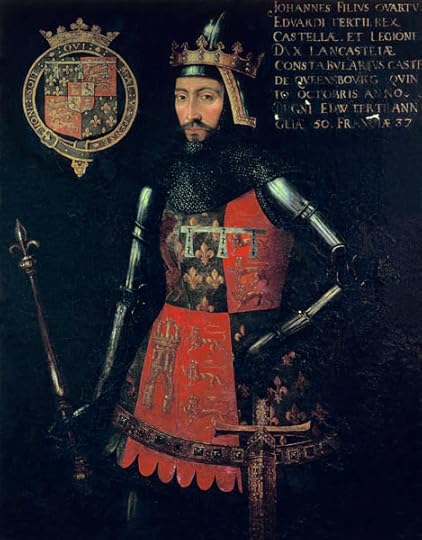
John of Gaunt with his coat of arms attributed to Lucas Cornelisz de Kock source: Wikipedia
But even this wasn't the end of the story. Richard was antagonistic toward John of Gaunt and this ill-will was transferred to his cousin Henry of Bolingbroke, especially after Henry joined the Lords Appellant and nearly cost him his throne in 1388. After the Appellant crisis, when Gaunt returned from Portugal, Richard received him joyfully back into the country; he had finally discovered that Gaunt's presence was the only factor that kept his rebellious magnates at bay. In this time frame, by all indications, he restored Edward III's entail and treated Gaunt as his heir—at least for the next five years.
But this favor did not extend to Bolingbroke. In 1394, as Richard was planning his expedition to Ireland, Gaunt petitioned Parliament to appoint Bolingbroke as Keeper of the realm. The Keeper was traditionally the heir to the throne, so Gaunt was fishing for a commitment. He couldn't serve as Keeper himself because he was due to leave for the Aquitaine, so naturally Henry—next in line according to the entail—would take his place. However the Earl of March raised a strong objection, for he felt that he was heir apparent (it is possible he did not know about Edward III's entail). Richard told them both to be silent and instead decided that his uncle Edmund of Langley, Duke of York (Gaunt's younger brother) would be Keeper in his absence.
This was a whole new turn of events! Suddenly Gaunt was out and Edmund was in. From that point on, relations between Richard and the House of Lancaster began to sour. The King showered favors on his cousin, York's son Edward, and created him Duke of Aumale. Whether Richard had intended to make York his heir, as Ian Mortimer concluded, remains speculation. If this was the case, it's puzzling that Edmund defected to Bolingbroke, thus giving up his own—and his son's—potential claim to the throne. Perhaps he had no inclination to be king; he was thought by many to be an indolent, irresolute fellow. Nonetheless, it was Edmund of Langley who fathered the House of York which proved so formidable in the Wars of the Roses.
Richard found it useful to keep everyone in suspense about the succession and never did proclaim a definite heir, though for the last several years he favored his fair-weather cousin Edward Duke of Aumale. When Bolingbroke invaded England, Aumale eventually went over to his side. That was the end of Edward's possible aspirations!
After Richard's usurpation, Henry IV chose to justify his claim—not by force of arms, but by citing his double descent from Henry III (through Edward III on his father's side and Edmund "Crouchback"—younger son of Henry—on his mother's side). Nonetheless, the Lancastrian line petered out in two generations, leaving the country ripe for a dynastic struggle—precipitated, many say, by the murder of the last true Plantagenet king.
In the end, could it be said that Richard II was usurped by his natural heir? He certainly wouldn't have thought so! His reckless decision to disinherit Bolingbroke showed all the characteristics of personal enmity. Many historians think he was only waiting for Gaunt to drop dead before confiscating the Lancastrian inheritance and eliminating Henry's influence forever. But he reckoned without his own unpopularity, and without Bolingbroke's courage and decision. It's ironic that the one person he strove so carefully to eliminate from the succession turned out to be the very man who destroyed his rule, his life, and his reputation.
Further Reading:
Bennett, Michael, Edward III's Entail and the Succession to the Crown, 1376-1471, from "The English Historical Review, Vol. 113, no. 452 (June 1998), pp.580-609
Given-Wilson, Charles, Richard II, Edward II, and the Lancastrian Inheritance, from "The English Historical Review, Vol. 1009, No. 432 (June, 1994), pp.553-571
Mortimer, Ian, Richard II amd the Succession to the Crown, from "History", Vol. 91, No. 3 (303) (July 2006), pp. 320-326
A King Under Siege:Part 1 of The Plantagenet Legacy
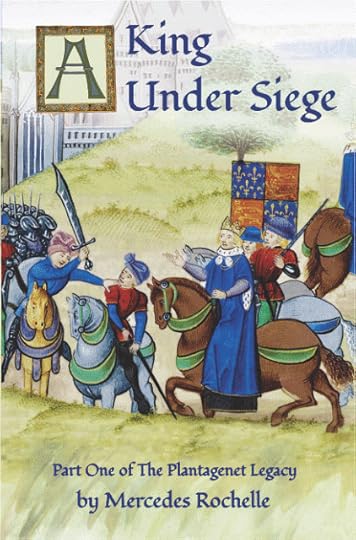
Coming soon...
Mercedes Rochelle
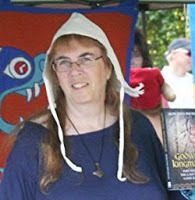 Born in St. Louis MO with a degree from University of Missouri, Mercedes Rochelle learned about living history as a re-enactor and has been enamored with historical fiction ever since. A move to New York to do research and two careers ensued, but writing fiction remains her primary vocation. She lives in Sergeantsville, NJ with her husband in a log home they had built themselves.
Born in St. Louis MO with a degree from University of Missouri, Mercedes Rochelle learned about living history as a re-enactor and has been enamored with historical fiction ever since. A move to New York to do research and two careers ensued, but writing fiction remains her primary vocation. She lives in Sergeantsville, NJ with her husband in a log home they had built themselves.Mercedes loves to hear from readers. You can find her: Website • Blog • Facebook • Twitter.
Published on November 21, 2018 21:30
November 20, 2018
Life in the Time of Sailing Ships - Part II by Jayne Davis #History #Ships #Regency @jaynedavis142
Life in the Time of Sailing Ships - Part II By Jayne Davis
In Part I of Life in the Time of Sailing Ships I looked at some phrases in everyday language that originated in the days of sail. A couple of comments were words to the effect of ‘How did so many men live on that?!’So this post is about how the sailors lived on a ship of the line such as HMS Victory, or a frigate such as HMS Trincomalee. Officers shared small cabins, but the facilities for the ratings were much less civilised. The photos here are from my visits to the two ships mentioned.
How many men… and women?
HMS Victory was a first-rate ship of the line, meaning it had over 100 guns, and a crew of around 850 men. HMS Trincomalee had 39 guns and a crew of around 350. The crew numbers given are the number of men and boys officially on the ship’s books, but many women went to sea as well. Their presence was tolerated, not official, and so they do not appear on the official records. They acted as seamstresses, tended the sick, or helped the powder monkeys (boys who carried charges of gunpowder from the powder store to the gunners).
Sleeping
Officers (and any wives or loose women they had) slept in cots, with a degree of privacy—the more senior had larger quarters, and on a flagship like Victory, there would not only be a large cabin with stern windows for the ship’s captain, but similarly impressive quarters above that for the Admiral.
 An officer’s cabin on HMS Trincomalee.
An officer’s cabin on HMS Trincomalee.The ratings were not so lucky. They slept on one of the gun decks. As you can see in the photo below, the guns take up a fair amount of space. In this image the guns are ‘run out’, with the ends sticking out through the gun ports as they would be when ready to fire. When the ship was not cleared for action, the guns would be completely inside the ship with the gun ports closed to keep spray out. Not only did this leave less space on the deck, but also reduced the light and ventilation.
 A gun deck on the Victory, ready for action, with a tourist for scale.
A gun deck on the Victory, ready for action, with a tourist for scale.So where did the men sleep? In hammocks, slung from the beams above the guns.
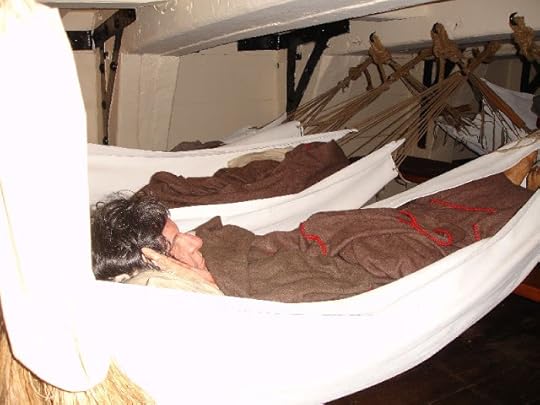 Hammocks slung on HMS Trincomalee.
Hammocks slung on HMS Trincomalee.At sea, most sailors got only 4 hours’ sleep a night. The crew of a ship was divided into two watches, apart from the Captain and some of the warrant officers such as the purser or carpenter. At sea, there would always be one watch on duty, ready to handle the ship. One watch would sling their hammocks and sleep from 8 until midnight, then the other watch would sleep until 4 in the morning. From then on, both watches were awake until 8 the following evening. When the hammocks were not being used, they were rolled up into long sausage shapes with a waterproof cover, and stowed in the nettings along the edges of the upper decks.
 Netting on HMS Victory. The bagged hammocks were stored between the two lines of netting, and provided some protection against musket or pistol fire in action.
Netting on HMS Victory. The bagged hammocks were stored between the two lines of netting, and provided some protection against musket or pistol fire in action.Storage of possessions was also a problem. A sailor with only a few possessions could roll up spare clothing and small items inside his hammock, but a man with a sea chest would have to stow it on a lower deck during the day.You might have got better sleeping accommodation if you were ill. The Sick Bay on HMS Victory isn’t large, but includes some cots. It is on a higher gundeck than the main sleeping accommodation, allowing more light and air, and also means men with contagious diseases could be kept separate from the rest of the crew. But as with most things on a warship, the guns were the most important thing – the contents of the sick bay would be moved elsewhere if the ship went into action.
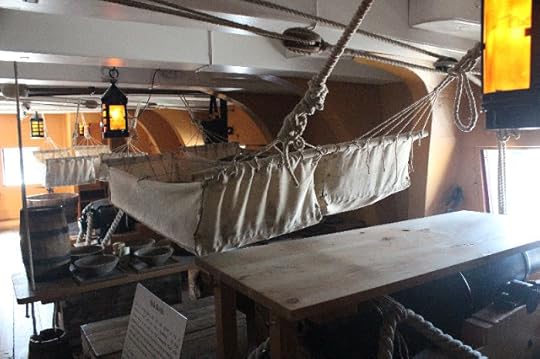 The Sick Bay on HMS Victory with cots slung from the ceiling. Note the table in the foreground, mounted on one of the guns.
The Sick Bay on HMS Victory with cots slung from the ceiling. Note the table in the foreground, mounted on one of the guns.Eating Officers dined in the wardroom, on a proper table. If you visit HMS Victory, you can see a long mess table of polished wood, set out with glasses and fine china. Officers who could afford extras did not stint themselves.However even they could not always avoid the guns. The larger cabins often contained one or two guns, and were divided from each other by removable partitions which were taken down when the ship went into action.
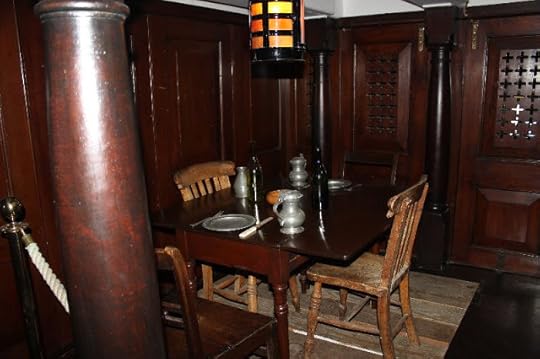 An officers’ dining area on HMS Victory
An officers’ dining area on HMS VictoryThe men ate on tables between the guns, suspended from the ceiling, or sometimes just had to sit on their sea chests.
 A table a ‘mess’ of six men on Victory. This one is in the sick bay, hence the cot hanging above it. Note the gun on the left.
A table a ‘mess’ of six men on Victory. This one is in the sick bay, hence the cot hanging above it. Note the gun on the left.The ‘heads’And the question that most kids (and some adults) ask is, how did they go to the loo? Again, rank comes into this. Officers had small private rooms, with the kind of toilet that consists of a plank with a hole in it to sit on, with a container underneath that could be emptied.Other ranks used the heads. Toilets on ships today are still referred to as heads, as in ‘I’m going to the head’. This comes from the location of toilets in sailing ships at the head, or front, of the ship. Not only were they at the front, but they were outdoors, allowing waste to fall directly into the sea.
 The bows of HMS Victory. The area behind the netting at the top would have had seats with holes, allowing waste to drop down through the open structure beneath it.
The bows of HMS Victory. The area behind the netting at the top would have had seats with holes, allowing waste to drop down through the open structure beneath it.Further reading:
The Wooden World, by N A M Rodger, is an excellent history of the Georgian Navy, and the source of many of the details in this article.
The Mrs MacKinnons

England, 1799Major Matthew Southam returns from India, hoping to put the trauma of war behind him and forget his past. Instead, he finds a derelict estate and a family who wish he'd died abroad.Charlotte MacKinnon married without love to avoid her father’s unpleasant choice of husband. Now a widow with a young son, she lives in a small Cotswold village with only the money she earns by her writing.Matthew is haunted by his past, and Charlotte is fearful of her father’s renewed meddling in her future. After a disastrous first meeting, can they help each other find happiness?4.7* average on Amazon, available on Kindle Unlimited.
Amazon
Jayne Davis
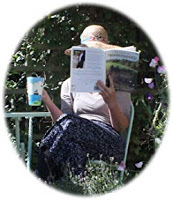 Jayne Davis writes historical romances set in the late Georgian/Regency era, published as both ebooks and paperbacks.She was hooked on Jane Austen and Georgette Heyer as a teenager, and longed to write similar novels herself. Real life intervened, and she had several careers, including as a non-fiction author under another name. That wasn't quite the writing career she had in mind...Finally, she got around to polishing up stories written for her own amusement in long winter evenings, and became the kind of author she’d dreamed of in her teens. She is now working on the first few books in the Marstone Series, set in the late Georgian/early Regency period.
Jayne Davis writes historical romances set in the late Georgian/Regency era, published as both ebooks and paperbacks.She was hooked on Jane Austen and Georgette Heyer as a teenager, and longed to write similar novels herself. Real life intervened, and she had several careers, including as a non-fiction author under another name. That wasn't quite the writing career she had in mind...Finally, she got around to polishing up stories written for her own amusement in long winter evenings, and became the kind of author she’d dreamed of in her teens. She is now working on the first few books in the Marstone Series, set in the late Georgian/early Regency period.You can find Jayne: Website • Blog • Pinterest.
Published on November 20, 2018 23:00
November 19, 2018
A conversation with Historical Fiction author — John Anthony Miller #amwriting #HistoricalFiction #WW1 @authorjamiller
A conversation with Historical Fiction author — John Anthony Miller.
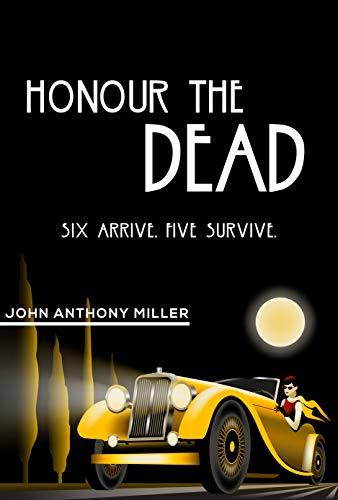
Hello, John. It is so great to see you on Myths, Legends, Books & Coffee Pots. For the readers who may not have come across your work, could you tell us a little about yourself?
 Of course! My name is John Anthony Miller. I live in the U.S., in southern New Jersey, and a life-long love of travel and history has motivated by writing. My fifth book, Honour the Dead, a historical murder mystery set in the 1920’s, has just been released.
Of course! My name is John Anthony Miller. I live in the U.S., in southern New Jersey, and a life-long love of travel and history has motivated by writing. My fifth book, Honour the Dead, a historical murder mystery set in the 1920’s, has just been released. I like to write about ordinary people compelled to do extraordinary things when faced with tragedy, like a global catastrophe or personal demons – challenges they struggle to overcome. My first four books are about WWII, but not generals or admirals or politicians, but a reporter, a history teacher, a banker, a violinist. They become heroes, just as many other ordinary people became heroes during the global conflict, their stories difficult to imagine in a world that is now so different, but in some ways, still the same. I also like to use the location of the novel as a character, often exotic, richly described, a place where people have either been or might someday like to go. My first four books are set in Singapore, Berlin, Lisbon, and Paris. For my fifth novel, Honour the Dead, I chose Lake Como, Italy, one of the most beautiful places in the world and a personal favorite of mine.
Your books sound utterly compelling. What inspired you to write the Honour the Dead?
I was intrigued by the utter devastation wrought by the First World War, which has since been overshadowed by the cataclysmic Second World War, so I set the novel in the 1920’s. I wanted to write about survivors, people desperately trying to forget the horrific tragedies they endured, losing family and friends, neighbours and coworkers – all victims to a war waged in muddy trenches with chlorine gas, the horror amplified by modern inventions like the tank and airplane. And even in 1921, three years after the fighting ended, I wanted to show that, regardless of how bright the future might seem, the past still clings tightly, refusing to let go.
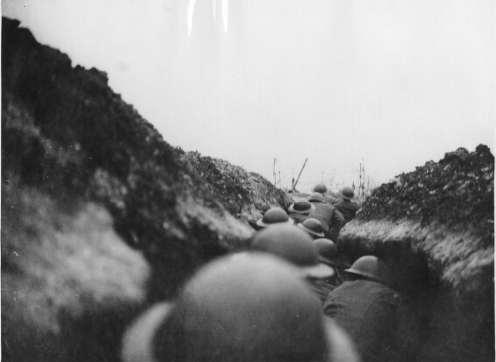 National Library of Scotland — John Warwick Brooke (Photographer) Licence: CC-BY-NC-SA
National Library of Scotland — John Warwick Brooke (Photographer) Licence: CC-BY-NC-SAYou are quite right, John. War does not end with the signing of an agreement; those who survived take their scars both physically and mentally home with them. What were the challenges you faced in researching this period of history?
I think most historical novels face the same challenges – the accurate description of daily life during the time period. I find that internet research tends to be high-level, and for the details needed to keep readers immersed in the story, I resort to books written about the time period.
I am sure all Historical Fiction authors would agree with you about the challenges of writing about their particular era. There are many books about the 1920’s. Can you tell us what sets your novel apart from those that have come before?
I think what makes Honour the Deadappealing to readers is that it crosses genres and it’s a series of contradictions. It’s a historical novel, yet a murder mystery. It’s a murder mystery, yet a psychological thriller. It takes place in an insane asylum, but in Lake Como – one of the most beautiful locations in the world. Although set in Italy, the characters are largely British. The unifying theme is that all involved suffer from the horrific tragedies ofthe First World War.
I am more intrigued than ever about you latest book. If I may be so bold to ask… What are you currently working on?
My literary agent already has my next novel – For Those Whose Dare – which is about an escape from East Berlin in 1961, just after the Berlin Wall was constructed. I’m now in the process of finishing a New Orleans murder mystery set in 1926 – Sinner, Saint, or Serpent – in which three strong female characters are suspects in the murder of a wealthy, but ruthless, businessman. And once that’s completed, it’ll be time to start another. I may return to WWII, or explore a completely different time period. History gives us so much to work with – don’t you agree?
I do indeed. Thank you so much for stopping by and chatting with me today.
It has been a pleasure, Mary Anne. I hope your followers enjoy reading Honour the Dead as much as I enjoyed writing it.
I am sure they will.
Honour the Dead

Honour the Dead is about six English survivors of WWI who converge on Lake Como, Italy in 1921: four men, two women = one corpse and one killer.
Penelope Jones, a wealthy socialite, is admitted to Lakeside Sanitarium, convinced someone is trying to kill her. Her husband, Alexander Cavendish, a WWI hero, is having an affair with her closest friend and owes gambling debts to Billy Flynn, a London gangster. Her father, Wellington Jones, is fighting the collapse of his business empire, and knows about Cavendish’s affair and gambling debts. Wellington needs money desperately and knows Penelope will inherit Cavendish’s estate, should anything happen to him. Dr. Joseph Barnett, Penelope’s doctor, struggles to control images of a war he can’t forget. He despises Cavendish, having served with him in the war. Barnett doesn’t see a war hero, but a despicable murderer who forced young men to die. Rose Barnett, the doctor’s wife, is a famous poet with a sordid secret. Rose was a nurse in France during the war, where she committed five mercy killings on horrifically wounded soldiers. Cavendish, the only witness, is blackmailing her. Who is the corpse and who is the killer?
Amazon UK • Amazon US
To find out more about John and his books: Website • Amazon • Goodreads• Twitter.
Published on November 19, 2018 23:00
The Coffee Pot Book Club
The Coffee Pot Book Club (formally Myths, Legends, Books, and Coffee Pots) was founded in 2015. Our goal was to create a platform that would help Historical Fiction, Historical Romance and Historical
The Coffee Pot Book Club (formally Myths, Legends, Books, and Coffee Pots) was founded in 2015. Our goal was to create a platform that would help Historical Fiction, Historical Romance and Historical Fantasy authors promote their books and find that sometimes elusive audience. The Coffee Pot Book Club soon became the place for readers to meet new authors (both traditionally published and independently) and discover their fabulous books.
...more
...more
- Mary Anne Yarde's profile
- 159 followers



